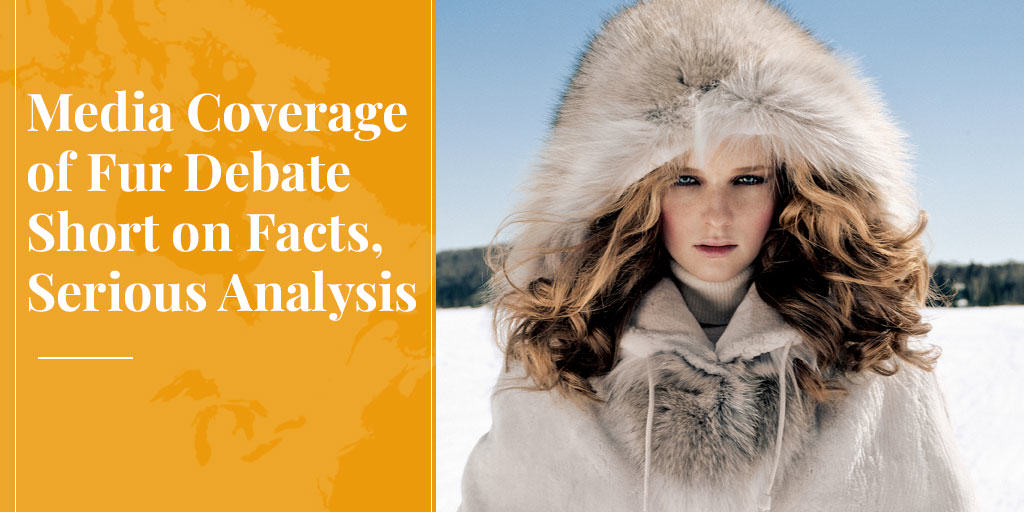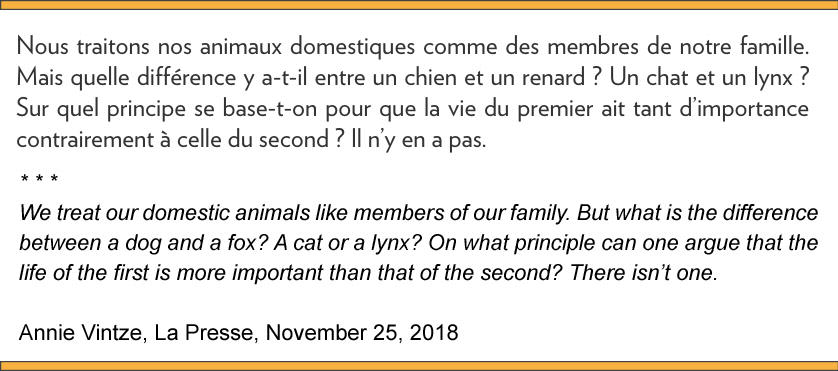
One of the most frustrating aspects of the current fur debate is the lack of any real facts or serious analysis in most media reports and public discussion.
For years, activists have circulated images of injured animals to support their claim that fur farming should be banned. This is the logical equivalent of showing photos of gruesome car crashes to argue for the elimination of motorized transport. But pictures speak louder than words – especially in a 164-character universe. So fur is often associated with animal cruelty, with little understanding or recognition of government regulations, industry standards, and all the scientific work that’s been done over the past 40 years to promote humane practices in the trade.
SEE ALSO: Calling PETA: US fur farming is strictly regulated.
More recently, anti-fur campaigning has spawned an even more simplistic “ethical” argument: we shouldn’t use animals for fur because we now have man-made textiles to keep us warm. Conversely, because no animals are killed (at least not directly) to make synthetics, faux is now frequently dubbed as “ethical fur”.
Vegans Say We’re Evil
This line of thinking (or non-thinking) has been encouraged by the recent wave of militant veganism, promoting the notion that any use of animals is morally indefensible. According to this emerging vegan doctrine, if those of us who continue to consume meat and other animal products are not outright evil, we are certainly guilty of moral sloth for failing to recognize the impact of our actions.
This line of argument was evident in a recent opinion piece published in La Presse, Quebec’s most important daily newspaper. Teacher and children’s writer Annie Vintze acknowledged that fur is warm and beautiful, and that she herself once would have worn it without question. Recently, however, her adult daughter made her understand that wearing fur makes us “complicit in animal suffering”. If we’re not ready to kill our pet dogs and cats for fur, she asks, why is it okay to kill coyotes and foxes?

SEE ALSO: 5 reasons why wearing fur is not like wearing your pet.
Vintze counselled patience with those of us who have not yet seen the light. Rather than criticism, she suggests, fur wearers need gentle encouragement to reflect upon the evil of our ways. What was most striking about her 600-word condemnation of fur was the complete lack of interest in, or consideration of, the real ecological and animal-welfare contributions of the modern fur trade. That there are non-animal alternatives is assumed to be reason enough for rejecting fur.
In response, I sent the following letter to La Presse. It has not yet been published, but I thought some of the arguments might be useful next time you find yourself in a discussion about the ethics of fur.
SEE ALSO: Is it ethical to wear fur? from the website of Truth About Fur.
* * *
Fur – An Ethical Choice!
Response to “Manteaux de fourrure complices de la souffrance animale”
While acknowledging that fur is beautiful and part of our Quebec winter heritage, Annie Vintze argues that we should no longer wear it because we now have synthetic materials to keep us warm, materials that don’t involve the killing of animals.
A review of the facts, however, suggests that fur is still an ethical choice for those who care about protecting nature.
Fact: Many fur animal populations must be controlled even if we didn’t use fur. Coyotes that provide fur trim for our parkas are rapidly expanding their range and numbers across North America. They are the main predator of lambs and calves on farms, and are now attacking pets and even people in cities, a clear sign of overpopulation. Over-populated raccoons spread rabies; beavers flood property, roads and fields; muskrats undermine stream banks; and the list goes on.
SEE ALSO: Reasons we trap, from the website of Truth About Fur.
Fact: We have changed the natural environment in many ways, so now we must take responsibility for maintaining a balance between wildlife and available habitat. Keeping wildlife populations within the limits their habitat can support helps to ensure more stable and healthy wildlife populations. But if we have to kill some animals, surely it is more ethical to use their fur than to waste it?
Fact: Most wild species produce more young than their habitat can support to maturity. Trapping is strictly regulated to ensure that we use only part of this natural surplus. This is an excellent example of “the sustainable use of nature”, a central conservation principle promoted by the International Union for Conservation of Nature (IUCN).
Fact: Canada is the world leader in research to develop humane trapping methods, work that provided the scientific basis for the Agreement on International Humane Trapping Standards (AIHTS).
SEE ALSO: Neal Jotham: A life dedicated to humane trapping.
Fact: Fur is now also produced on family-run farms. Farmed mink and foxes are fed left-overs from our own food production, the parts of chicken, pigs, and fish that we don’t eat. The animals’ manure, soiled straw bedding, and carcasses are composted to produce organic fertilizers to restore the soil – completing the agricultural nutrient cycle.
Fact: Farmed fur animals receive excellent nutrition and care; this is the only way to produce the high quality of fur for which North America is known.
Most important from a consumer perspective, fur is remarkably warm, durable and long-lasting. Unlike most clothing, a fur coat can be restyled as fashions change. And fur is biodegradable: after decades of use, you can throw it into the garden compost.
By contrast, the synthetics proposed by animal activists are generally made from petroleum, a non-renewable, highly polluting, and non-biodegradable material. Recent research is revealing that these synthetics leach micro-particles of plastic every time they are washed – plastic that passes into our waterways and marine life, and is now even being found in bottled water.
Some people, of course, choose not to use any animal products, even for food. This is a matter of personal choice that we all can respect.
But for the 95% of Canadians who eat meat and believe that humans do have a right to use animals – so long as this is done responsibly and sustainably – fur is not only warm and beautiful, it is also a responsible and ethical clothing choice.











This is something i have never ever read.very detailed analysis.
The fur industry still has a large roll to play in the Science of maintaining a Conservation program that protects species health rather then individuals from a species. The cull of the few protects the many from over burdened populations in the herd or the pack from starvation, contagious pestilence, territorial infighting & more cruel deaths of winter kill & tooth & claw death that can take a much crueler path than a humane kill offered by humane furriers & meat eaters..